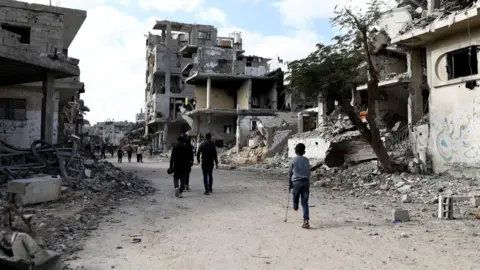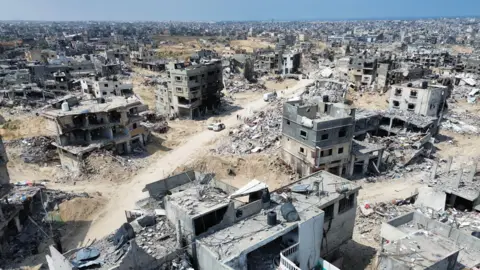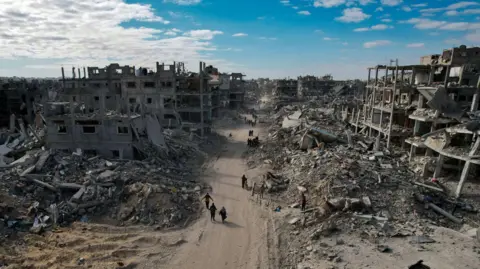 Reuters
ReutersOn the first full day of peace in Gaza on Monday, rescue workers and civilians began to reckon with the sheer scale of the destruction to the Strip.
Gaza’s Civil Defence agency – the strip’s main emergency response service – said it feared there were more than 10,000 bodies still buried under the vast sea of rubble.
Spokesman Mahmoud Basal told the BBC that they hoped to recover the dead within 100 days, but were likely to be delayed by a deficit of bulldozers and other essential equipment.
New images from Gaza following Sunday’s ceasefire showed scenes of total devastation wrought during 15 months of Israeli offensive, particularly in the north of the enclave.
The UN has previously estimated that 60% of structures across Gaza have been damaged or destroyed.
Though the sounds of bombing were replaced by celebrations as the ceasefire began on Sunday, the reality facing people across Gaza remains desperate.
According to the UN World Food Programme (WFP), the war has left more than two million Gazans homeless, without income, and completely dependent on food aid to survive.
That aid began to enter Gaza immediately after the ceasefire on Sunday and the UN said at least 630 lorries went into the Strip before the end of the day.
On Monday, a further 915 lorries entered the enclave, the UN said, the highest number since the start of the war 15 months ago.
 EPA
EPASam Rose, acting director of Unrwa, the UN’s Palestinian refugee agency in Gaza, said the aid supplies were just the beginning in the challenge of bringing the strip back to life.
“We’re not just talking about food, healthcare, buildings, roads, infrastructure, we’ve got individuals, families, communities that need to be rebuilt,” he said.
“The trauma that they’ve gone through, the suffering, the loss, the grief, the humiliation, and the cruelty that they’ve endured over the past 16 months – this is going to be a very, very long road.”
In Israel, the families of the three hostages who were freed in the first exchange spoke at a news conference in Tel Aviv on Monday night. Mandy Damari, the mother of dual Israeli-British citizen Emily Damari, said Emily was in “high spirits” and “on the road to recovery” despite losing two fingers in the Hamas attack on 7 October 2023.
Meirav Leshem Gonen, the mother of Romi Gonen, said: “We got our Romi back, but all families deserve the same outcome, both the living and the dead. Our hearts go out to the other families.”
Before the news conference, Israeli authorities released new footage showing Damari, 28, Gonen, 24, and Doron Steinbrecher, 31 tearfully greeting their mothers on Sunday just moments after being taken out of Gaza.
If the first phase of the ceasefire holds, 30 more hostages will be released from Gaza over the next 40 days in return for about 1,800 Palestinians freed from Israeli jails.
 EPA
EPAPalestinian health authorities estimate that more than 46,900 people were killed in Gaza during the more than 15 months of war and more than 110,700 were wounded.
The ministry does not distinguish between civilians and combatants but it says the majority of the dead are women and children – an assertion backed by the UN.
A UK-led study published by the medical journal The Lancet this month suggested that the health ministry figures may underestimate the death toll by more than 40%.
The Gaza Civil Defence agency said in a statement on Monday that 48% of its own personnel had been killed, injured or detained during the conflict, and 85% of its vehicles and 17 out of 21 facilities had been damaged or destroyed.
Though the risk from air strikes is gone, for now, the grim work continues for the remaining Civil Defence workers. Pictures shared with the BBC by members of the agency in northern Gaza on Monday showed them performing harrowing work, including the recovery of dead babies and of human remains in poor condition.
“In every street there are dead. In every neighbourhood there are people under the buildings,” said Abdullah Al-Majdalawi, a 24-year-old Civil Defence worker in Gaza City.
“Even after the ceasefire we received many calls from people saying please come, my family is buried under the rubble.”
Malaak Kasab, a 23-year-old recent graduate displaced from Gaza City, told the BBC on Monday that members of her own family were among those yet to be recovered.
“We have lost a lot of members of our family and some are still under the destroyed buildings,” she said. “There are a lot of people under the rubble – everybody knows about this.”
Kasab’s family home in an apartment building was not completely destroyed, she said, but very badly damaged. “There are no doors, no windows, no water, no electricity, nothing. Not even wood to make a fire. It is unliveable.”
Movement is still dangerous for displaced Gazans as the Israeli military begins the process of withdrawing from populated areas of the Strip.
The Israel Defence Forces (IDF) has warned people not to approach its personnel or installations, nor enter a buffer zone it created around the border of Gaza and around the Netzarim corridor, which bisects Gaza separating north from south.
But many residents were eager to see what was left of their homes sooner than they had been advised. Hatem Eliwah, a 42-year-old factory supervisor from Gaza City, said he was considering setting out on foot from his shelter in Khan Younis in the south.
“We have been waiting for this ceasefire like people waiting to enter heaven,” Eliwah said. “I lost two of my brothers and their families. I lost cousins, uncles. The only thing I still hope for is to go home.”
There are grave concerns on both sides that the deal could collapse even before the first phase is complete in roughly six weeks, and Israel has stressed it reserves the right to resume military action in Gaza at any time.
Speaking at a meeting of the UN Security Council on Monday, Secretary-General Antonio Guterres welcomed the deal as a “ray of hope” and said its obligations must be met.
But Guterres warned of a worsening situation in the occupied West Bank, which has seen a huge rise in Israeli settler attacks against Palestinian villages since the Hamas attack on Israel of 7 October 2023.
“Senior Israeli officials openly speak of formally annexing all or part of the West Bank in the coming months,” Guterres said, adding: “Any such annexation would constitute a most serious violation of international law.”
Muath Al-Khatib contributed to this report






